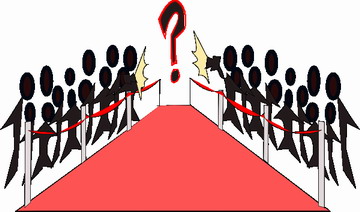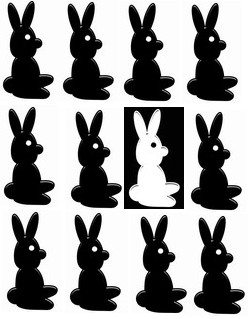As the democratization of film has made it possible for just about anyone to make a film, it has conversely made it more difficult for the individual filmmaker and his or her films to stand out. Online content platforms now offer a hundred times more films in their catalogs then the films cataloged by IMDb from the inception of film (1,764,727 titles as of 14 Jan 2011). So despite assertions to the contrary, branding is more important than ever.
 Filmmakers Are Brands, Their Films Are Products Though difficult for some in a creative pursuit to accept, in the words of Moonstruck (1987): “Snap out of it!” The music world has brands Madonna Louise Ciccone and Joanne Angelina Germanotta, known by their much more memorable brand names, Madonna and Lady Gaga.
Filmmakers Are Brands, Their Films Are Products Though difficult for some in a creative pursuit to accept, in the words of Moonstruck (1987): “Snap out of it!” The music world has brands Madonna Louise Ciccone and Joanne Angelina Germanotta, known by their much more memorable brand names, Madonna and Lady Gaga.
Consistency Counts When your audience knows what they can expect from your “brand”, even if it is to be continually surprised, you’ve engaged them with your brand proposition. Independent filmmakers need to develop a fanbase, a community that eagerly awaits each new film. Just as Hollywood is now focused on known franchise films because they have pre- awareness that results in more cost-effective marketing, certain independent filmmakers have developed cost-effective pre-awareness for themselves due to the consistency of their work. Woody Allen, Pedro Almodovar and Wes Anderson are a few examples.
To reinforce rather than dilute a brand, dependability is essential. If you doubt this, remember that when Bob Dylan unexpectedly went on stage for the first time with an electric guitar, the reaction of his adoring fans was immediate: they booed him. And Miley Cyrus was able to break her long-standing brand image with a single well-timed twerk that caused industry shockwaves. However, unless you are attempting to rebrand yourself, be consistent.
Put your brand name on everything you do and always in the same way. I’m continually surprised when individuals in the LinkedIn group I manage, Independent Film Producers, use name variations other than the way they list themselves on IMDb. Make it easy for people to find your brand and make them certain that it’s your brand.
 Be Differentiated Take a look at IMDb, as that is the reference point for most filmmakers. When there are a half-dozen individuals named “James Jones”, you might consider being the only “James Earl Jones”. Being differentiated is even more important when you have a common name and aren’t famous. The viewer might not recognize any of the film titles listed and know which one of these individuals is you. David Greenwald is the editor of some of Ed Burns’ films. Alas, that isn’t me.
Be Differentiated Take a look at IMDb, as that is the reference point for most filmmakers. When there are a half-dozen individuals named “James Jones”, you might consider being the only “James Earl Jones”. Being differentiated is even more important when you have a common name and aren’t famous. The viewer might not recognize any of the film titles listed and know which one of these individuals is you. David Greenwald is the editor of some of Ed Burns’ films. Alas, that isn’t me.
Be Differentiated Visually As Well As film is a visual medium, everything you do should leave a visual impression. Don’t tell them when you can show them. Have a distinct visual style. Some directors, like Almodovar, work in a noticeable color palette. Steve Jobs distinguished himself from every other CEO with his 501 jeans and black turtlenecks.
Plan Ahead When you start a project on Kickstarter or another crowdfunding site, carefully consider your film title. My friend, actor Eddie Jemison, launched his directorial debut on Kickstarter under the title “Cloud Talk”. Once the project was underway, he could not change the project name to reflect the registered film title, “King of Herrings”. As a known actor, people could still find his project through his name. Not everyone has that advantage.
Think URL Before launching a film project, check the availability of the website with that name. That’s where your audience, the press, festival organizers and potential distributors will look for you. So if you are going to name your film “King of Herrings”, before committing to that name, be sure that the URL www.kingofherrings.com is available. (It was.)
A Name is a Name is a Name Apologies to Gertrude Stein, but film names count. In general, you’d like them to be short, distinctive and memorable: “Drive”, “Paranormal Activity”, “The Station Agent”. (Similarly, “Kickstarter” and “Indiegogo” are great, “active” names for these Internet projects.)
The notable exception to the first part of this triumvirate, i.e. short, are the films of Lina Wertmuller. The original language titles of her films were noteworthy for always being whimsical and verbose. As soon as you heard the title, you knew it was a Wertmuller film. That’s great branding. She’s reported to hold the Guinness World Record for the Longest Film Title: “Un Fatto di Sangue Nel Comune di Siculiana Fra Due Uomini Per Causa di Una Vedova. Si Sospettano Moventi Politici. Amore-Morte-Shimmy. Lugano Belle. Tarantelle. Tarallucci e Vino”. No, you’ll never remember it, but you’ll never forget her after it.
 Think Internationally As the film business has become more international, naming is more important. When short, names are understandable and remain unchanged in foreign markets. Consolidating all press coverage under one name creates synergy. One Google search will reveal everything. A single name will also create immediate recognition by staff, festivalgoers, and buyers at international film festivals. But when you have a name like “Beasts of the Southern Wild”, they’ll need to translate, not the words, but the concept, in each foreign market. So in Italy, the distributor settled on “Re Della Terra Selvaggia” (Ruler of the Wild Earth).
Think Internationally As the film business has become more international, naming is more important. When short, names are understandable and remain unchanged in foreign markets. Consolidating all press coverage under one name creates synergy. One Google search will reveal everything. A single name will also create immediate recognition by staff, festivalgoers, and buyers at international film festivals. But when you have a name like “Beasts of the Southern Wild”, they’ll need to translate, not the words, but the concept, in each foreign market. So in Italy, the distributor settled on “Re Della Terra Selvaggia” (Ruler of the Wild Earth).
Working on a documentary about film titles in Italy, “Finding Titles: Se Mi Traduci Mi Cancelli” (Finding Titles: If You Translate Me, You Erase Me) reinforced the need for filmmakers to consider how their titles will work internationally. Filmmakers lose control in foreign markets. The translations of foreign titles in Italy often follow a formula that is almost “sing song” in nature: “If you do this, I will do that”. This makes it difficult to distinguish among them. In some cases, distributors create even more complications. Howard Hawks’ “Rio Bravo” is called “Un Dollaro d’Onore” and John Ford’s “Rio Grande” is called “Rio Bravo”. Since both feature John Wayne, I only realized this when I watched the wrong one.
 Have A Positioning and Signature To successfully position your brand, you’d like to identify and communicate what makes your brand unique and gives it value. You might also consider having a unique signature. Hitchcock branded himself by making a stoic cameo in each of his films and using his prominent silhouette, Jim Jarmusch by using a “deadpan” camera, and Ken Loach by featuring three legged dogs.
Have A Positioning and Signature To successfully position your brand, you’d like to identify and communicate what makes your brand unique and gives it value. You might also consider having a unique signature. Hitchcock branded himself by making a stoic cameo in each of his films and using his prominent silhouette, Jim Jarmusch by using a “deadpan” camera, and Ken Loach by featuring three legged dogs.
P.S. If you missed it, you may also want to read my other article, “Why Filmmakers Fail (You’re NOT Featured)” also on Hope for Film.
 David K. GREENWALD is a marketing and production consultant on independent features. He’s guided strategic planning for many blue chip brands, served as a television commentator on media and technology and worked on the launches of two media revolutions, home video and the Internet. Author of a manual on internet marketing, he’s the Manager of the LinkedIn group, Independent Film Producers, and a graduate of the Wesleyan University film program.
David K. GREENWALD is a marketing and production consultant on independent features. He’s guided strategic planning for many blue chip brands, served as a television commentator on media and technology and worked on the launches of two media revolutions, home video and the Internet. Author of a manual on internet marketing, he’s the Manager of the LinkedIn group, Independent Film Producers, and a graduate of the Wesleyan University film program.





